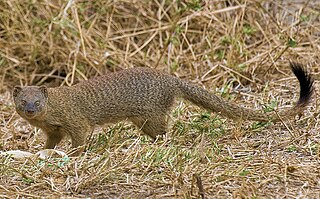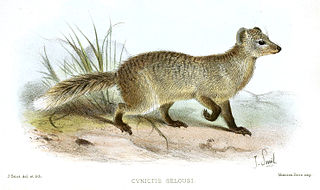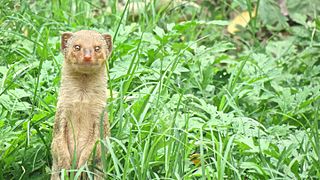Small Asian mongoose is a common name applied to two mammals which were formerly considered to be a single species:
Small Asian mongoose is a common name applied to two mammals which were formerly considered to be a single species:

A mongoose is a small terrestrial carnivorous mammal belonging to the family Herpestidae. This family is currently split into two subfamilies, the Herpestinae and the Mungotinae. The Herpestinae comprises 23 living species that are native to southern Europe, Africa and Asia, whereas the Mungotinae comprises 11 species native to Africa. The Herpestidae originated about 21.8 ± 3.6 million years ago in the Early Miocene and genetically diverged into two main genetic lineages between 19.1 and 18.5 ± 3.5 million years ago.

Grandidier's mongoose, also known as the giant-striped mongoose or Grandidier's vontsira, is a small carnivoran that lives only in a very small area of southwestern Madagascar, in areas of spiny forest vegetation. It is pale brown or grayish coloured, with eight wide, dark stripes on its back and sides. Grandidier's mongoose is larger than the related broad-striped Malagasy mongoose, G. fasciata, and its stripes are not as wide. The species is named after Alfred Grandidier.

The common kusimanse, also known as the long-nosed kusimanse or simply cusimanse, is a small, diurnal kusimanse or dwarf mongoose. Of three subfamilies of Herpestidae, the kusimanse is a member of Mungotinae, which are small and very social.

The ring-tailed vontsira, locally still known as the ring-tailed mongoose is a euplerid in the subfamily Galidiinae, a carnivoran native to Madagascar.

The crab-eating mongoose is a mongoose species ranging from the northeastern Indian subcontinent and Southeast Asia to southern China and Taiwan. It is listed as Least Concern on the IUCN Red List.

The Egyptian mongoose, also known as ichneumon, is a mongoose species native to the Iberian Peninsula, coastal regions along the Mediterranean Sea between North Africa and Turkey, tropical and subtropical grasslands, savannas, and shrublands in Africa. Because of its widespread occurrence, it is listed as Least Concern on the IUCN Red List.

Galidiinae is a subfamily of carnivorans that is restricted to Madagascar and includes six species classified into four genera. Together with the three other species of indigenous Malagasy carnivorans, including the fossa, they are currently classified in the family Eupleridae within the suborder Feliformia. Galidiinae are the smallest of the Malagasy carnivorans, generally weighing about 600 to 900 g. They are agile, short-legged animals with long, bushy tails.

The Angolan slender mongoose is a mongoose native to southwestern Africa, specifically southwestern Angola and northwestern Namibia. It has been listed as "Least Concern" on the IUCN Red List, as it is not threatened and thought to be common. It has a long, slim body and there are different colour forms, a black or dark brown form in the southern part of its range, and a yellowish- or reddish-brown form in the north. This mongoose inhabits dry, rocky habitats and feeds on insects, scorpions and small vertebrates.

The slender mongoose, also known as the black-tipped mongoose or the black-tailed mongoose, is a very common species of mongoose of sub-Saharan Africa.

The common dwarf mongoose is a mongoose species native to Angola, northern Namibia, KwaZulu-Natal in South Africa, Zambia and East Africa. It is part of the genus Helogale and as such related to Helogale hirtula.

The Indian grey mongoose is a mongoose species native to the Indian subcontinent and West Asia. It is listed as Least Concern on the IUCN Red List. The grey mongoose inhabits open forests, scrublands and cultivated fields, often close to human habitation. It lives in burrows, hedgerows and thickets, among groves of trees, and takes shelter under rocks or bushes and even in drains. It is very bold and inquisitive but wary, seldom venturing far from cover. It climbs very well. Usually found singly or in pairs. It preys on rodents, snakes, birds’ eggs and hatchlings, lizards and variety of invertebrates. Along the Chambal River it occasionally feeds on gharial eggs. It breeds throughout the year.

The white-tailed mongoose is a species in the mongoose family (Herpestidae). It is the only member of the genus Ichneumia.

Selous's mongoose is a mongoose species native to Southern Africa. It is the only member of the genus Paracynictis.

The broad-striped Malagasy mongoose is a species of Galidiinae, a subfamily of mongoose-like euplerids native to Madagascar. The species contains two known subspecies: Galidictis fasciata fasciata and Galidictis fasciata striata.

The narrow-striped mongoose is a member of the family Eupleridae endemic to Madagascar. It inhabits the Madagascar dry deciduous forests in western and southwestern Madagascar, where it lives from sea level to about 125 m (410 ft) between the Tsiribihina and Mangoky rivers. In Malagasy it is called bokiboky.

Feliformia is a suborder within the order Carnivora consisting of "cat-like" carnivorans, including cats, hyenas, mongooses, viverrids, and related taxa. Feliformia stands in contrast to the other suborder of Carnivora, Caniformia.

Helogale is a genus of the mongoose family (Herpestidae). It consists of two species and 12 subspecies:
Palustris is a Latin word meaning "swampy" or "marshy", and may refer to:

The small Indian mongoose is a mongoose species native to Iraq and northern South Asia; it has been introduced to many regions of the world.